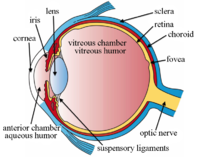
Photo from wikipedia
Choroidal neovascularisation (CNV) in the context of exsudative age-related macular degeneration (nAMD) can be divided into type 1 (occult) and type 2 (classical) membranes. Retinal angiomatous proliferation (RAP) or polypoidal… Click to show full abstract
Choroidal neovascularisation (CNV) in the context of exsudative age-related macular degeneration (nAMD) can be divided into type 1 (occult) and type 2 (classical) membranes. Retinal angiomatous proliferation (RAP) or polypoidal choroidal vasculopathy (PCV) are "rare subtypes" of chorioretinal neovascularisation and are distinguished by their distinct morphology and the sometimes worse response to therapy. Chorioretinal anastomosis, severe exsudates with serosanguinous pigment epithelial detachment and, in PCV, orange-red lesions in the papillomacular bundle can be diagnostic. Indocyanine green angiography (ICGA) is considered the gold standard for diagnosis of PCV and delivers important information for RAP too. Typical characteristics of PCV include foci of hyperfluoresence, with pulsatile filling in the early phase. This characterises choroidal polypoidal lesions, often in connection with an abnormal choroidal vascular network. In RAP, typical retino-retinal anastomosis can be identified, in particular in areas with pigment epithelial detachment. Optical coherence tomography (OCT) can complement diagnostic testing. In cases of RAP, early therapy initiation with intravitreal anti-VEGF is crucial for the prognosis of visual acuity. PCV can exhibit spontaneous regression. In active disease, photodynamic therapy (PDT) is efficient in the closure of PCV polyps. In association with CNV, it makes sense to combine PDT and intravitreal anti-VEGF medication. In spite of the initial increase in visual acuity, this state is normally "only" stabilised in the long term. In patients with idiopathic secondary CNV membranes (high myopia, post-inflammatory, post-traumatic changes or in hereditary connective tissue diseases), small "classical" type 2 membranes are mostly involved. Hence, these are strictly speaking not directly rare subtypes. Nevertheless, these patients are mostly younger, with less protracted illness and limited available regeneration ability of the retinal pigment epithelium (RPE): they may therefore differ favourably from the courses with nAMD, with earlier inactivation and with fewer required anti-VEGF injections. CNV with angioid streaks are a special case in this group. Unfortunately, these lesions have a recurrent, protracted and, in the end, mostly frustrating course.
Journal Title: Klinische Monatsblatter fur Augenheilkunde
Year Published: 2018
Link to full text (if available)
Share on Social Media: Sign Up to like & get
recommendations!